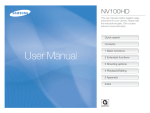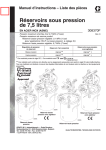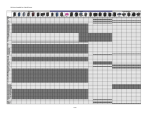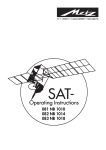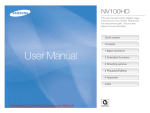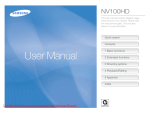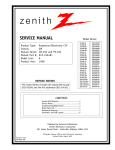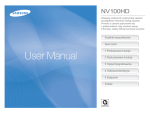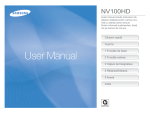Download Samsung TL34HDBLACK Quick start manual
Transcript
TL34HD Please refer to the warranty that came with your product or go to our website http://www.samsung.com/ for after-sales service or inquiries. The CE Mark is a Directive conformity mark of the European Community (EC) AD68-03085A This Quick Start Manual has been specially designed to guide you through the basic functions and features of your device. For more information, refer to the User Manual included on the supplied CD-ROM. Please read the Quick Start Manual and User Manual carefully to ensure safe and correct use. English/Español Copyright information ▪ Microsoft Windows and the Windows logo are registered trademarks of the Microsoft Corporation. ▪ HDMI, the HDMI logo and the term "High Definition Multimedia Interface" are trademarks or registered trademarks of HDMI Licensing LLC. ▪ QuickTime and QuickTime logo are trademarks or registered trademarks of Apple Computer, Inc., used under license. EN- Provided manuals Quick Start Manual Explains how to assemble and prepare your camera for its first use, capture photos or videos and transfer files to a PC. User Manual (CD-ROM) Explains how to shoot with various shooting modes, set shooting options, and use the settings menu. It also includes how to handle error messages and maintain your camera. Indication information In this manual, camera buttons are represented by bold type in brackets. For example, [Shutter] represents the Shutter button. Contents Please follow these procedures before using the camera. 1. Unpack… ………………………6 2. Insert the battery and memory card……………………7 3. Charge the battery and turn on your camera … ……………8 4. Select a language and set the date and time… ……………9 Camera layout… ……………… 10 Icons… ………………………… 12 Use the touch screen… ……… 13 Take a photo…………………… 14 Record a video… ……………… 15 Transfer files to a PC (for Windows)…………………… 16 Specifications…………………… 18 FCC notice……………………… 19 Get answers to common questions You can easily solve most problems by setting shooting options. There are more details about how to set shooting options in the CD version of the user manual. The subject's eyes appear red. This is caused by a reflection from the camera flash. • Set the flash option to Red Eye or Red Eye Fix. (See the user manual p.33) • If the photo has already been taken, select Red Eye Fix in the edit menu. (See the user manual p.57) Photos have dust spots. Dust particles floating in the air may be captured in photos when using the flash. • Turn the flash off or avoid taking photos in a dusty place. • Set ISO speed options. (See the user manual p.35) Photos are blurred. This may be caused by taking photos in low light conditions or holding the camera incorrectly. Set the Optical Image Stabilization (OIS) option or press [Shutter] halfway down to make sure the subject is focused. (See the user manual p.26) Photos are blurred when shooting at night. As the camera tries to let in more light, the shutter speed slows. This can make it difficult to steady the camera and may result in camera shake. • Turn the flash on. (See the user manual p.33) • Select the 6 mode. (See the user manual p.20) • Set ISO speed options. (See the user manual p.35) • Use a tripod to prevent your camera from shaking. Subjects come out too dark because of backlighting. When the light source is behind the subject or when there is a high contrast between the light and dark areas, the subject may come out shaded. • Avoid shooting in front of the sun. • Select BACKLIGHT in the 4 mode. (See the user manual p.20) • Set the flash option to Fill in. (See the user manual p.33) • Set the Auto Contrast Balance (ACB) option. (See the user manual p.41) • Adjust the exposure. (See the user manual p.40) • Set the metering option to Spot if a bright subject is in the center of the frame. (See the user manual p.42) EN- English ©2008 Samsung Electronics America, inc. The specifications of the camera or contents of this manual may be changed without prior notice due to upgrade of camera functions. p.1 ‘Health and Safety Information’ Health and Safety Information English Comply with the following precautions to avoid dangerous or illegal situations while operating the camera and keep this manual handy for future reference. Cautions Situations that could cause damage to your camera or other equipment Warnings Situations that could cause injury to yourself or others Do not use your camera near flammable or explosive gases and liquids Do not use your camera near fuels, combustibles, or flammable chemicals. Do not store or carry flammable liquids, gases, or explosive materials in the same compartment as the camera or its accessories. Keep your camera away from small children and pets Keep your camera and all accessories out of the reach of small children and animals. Small parts may cause choking or serious injury if swallowed. Moving parts and accessories may present physical dangers as well. Prevent damage to subjects’ eyesight Do not use the flash in close proximity (closer than 1m/3 ft) to people or animals. Using the flash too close to your subject’s eyes can cause temporary or permanent damage. Handle and dispose of batteries and chargers with care • Use only Samsung-approved batteries and chargers. Incompatible batteries and chargers can cause serious injuries or damage to your camera. • Never dispose of batteries in a fire. Follow all local regulations when disposing of used batteries. • Never place batteries or cameras on or in heating devices, such as microwave ovens, stoves, or radiators. Batteries may explode when overheated. Handle and store your camera carefully and sensibly Protect batteries, chargers, and memory cards from damage • Do not allow your camera to get wet—liquids can cause serious damage. Do not handle your camera with wet hands. Water damage to your camera can void your manufacturer’s warranty. • Avoid using or storing your camera in dusty, dirty, humid, or poorly-ventilated areas to prevent damage to moving parts and internal components. • Protect your camera from impact, rough handling, and excessive vibration to avoid serious damage. • Exercise caution when connecting cables or adapters and installing batteries and memory cards. Forcing the connectors, improperly connecting cables, or improperly installing batteries and memory cards can damage ports, connectors, and accessories. Do not insert foreign objects into any of your camera’s compartments, slots, or access points. This type of damages may not be covered by your warranty. • Avoid exposing batteries or memory cards to very cold or very hot temperatures (below 0°C/32°F or above 40°C/104°F). Extreme temperatures can reduce the charging capacity of your batteries and can cause memory cards to malfunction. • Prevent batteries from making contact with metal objects, as this can create a connection between the + and – terminals of your battery and lead to temporary or permanent battery damage. • Prevent memory cards from making in contact with liquids, dirt, or foreign substances. If dirty, wipe the memory card clean with a soft cloth before inserting in your camera. Use only Samsung-approved accessories Using incompatible accessories may damage your camera, cause injury, or void your warranty. Protect your camera’s lens Protect your lens from fingerprints and scratches. Clean your lens with a soft, clean, debris-free lens cloth. EN- EN- 1. Unpack 2. Insert the battery and memory card Optional accessories Remove the battery and memory card Camera AC adapter (SAC-47)/ USB cable (SUC-C4) AD44-00131A/AD39-00151A Camera case Memory cards AD69-01783A Memory card Sold as a set Rechargeable battery AD81-00884A Strap A / V cable Silver: AD63-02602A/ Black: AD63-02603A AD39-00150A Quick Start Manual AD68-03085A Software CD-ROM (User manual included) Push gently until the card disengages from the camera and then pull it out of the slot. Insert memory cards with the gold-colored contacts facing up. HDMI cradle manual Remote control AD68-03092A AD59-00164A Cradle (for charging the battery and connecting your camera to an HDTV or PC) HDMI cable (for viewing highresolution images or playing videos) AD61-03811A AD39-00152A Insert batteries with the Samsung logo facing down. Push the lock up to release the battery. Battery lock Battery Note The internal memory can be used as a temporary storage device when the memory card is not inserted. AD46-00189A EN- EN- English p.74 ‘About memory cards’ p.75 ‘About the battery’ 3. Charge the battery and turn on your camera 4. Select a language and set the date and time Charge the battery Turn on your camera Press [POWER] When you turn on your camera for the first time, select a language and set the date and time. Select a language Set the date and time 1 Touch to select a city from the world map 3 Language ENGLISH Language ENGLISH Date & Time 2008/01/01 Date & Time 2008/01/01 World Time London ➊ Date & Time 08 01 01 12 00 ➋ Touch to change Language Date & Tim e the number ENGLISH 2008/01/01 2 Language ENGLISH Date & Time Indicator light ▪ Red: Charging ▪ Green: Fully charged EN- ▪ Press [Playback] to view stored files. ▪ Press and hold [Playback] to mute camera sounds. Language 2008/01/01 Date & Time yyyy/mm/dd 4 Select a field ➌ Touch ➋ Language 2008/01/01 Date & Time yyyy/mm/dd FRANÇAIS mm/dd/yyyy mm/dd/yyyy DEUTSCH dd/mm/yyyy dd/mm/yyyy Off Off Touch to switch to Shooting mode ➊ S elect a date format EN- English p.75 ‘About the battery’ Camera layout AF-assist light/Timer lamp Shutter button When the flash is needed, the flash unit opens automatically if you press [Shutter] (Press down gently to close). See below Remote control sensor Lens Icon Caution • While not in use, keep the flash unit closed to prevent damage. • Forcing open the flash unit may cause damage to your camera. Microphone Description Take a photo conveniently with minimal settings Icon Mode Description 6 NIGHT Take a photo with options for shooting at night 1 Take a photo by setting options PROGRAM (except for shutter speed and aperture value) 5 BEAUTY SHOT Take a photo of a person with options to hide facial imperfections 8 MANUAL 4 SCENE Take a photo with options for a preset scene 3 MOVIE Record a video 2 7 EN-10 Mode Speaker Flash unit Mode dial AUTO DUAL IS Take a photo by setting options manually Take a photo with options suitable for reducing camera shake English POWER button Touch screen Status lamp ▪ Blinking: When saving a photo or video, MENU button Access the camera settings menu ▪ recording a voice memo, being read by a computer or printer, or out of focus Steady: When connecting to a computer or in focus Playback button Zoom T/Expand button Zoom W/Thumbnail button Tripod mount Battery chamber cover Insert a memory card and battery USB and A / V port EN-11 Use the touch screen The icons displayed will change according to the selected mode or options you set. Learn basic actions to use the touch screen. The touch screen works best when touched with the soft part of your finger. A B. Touch icons Icon B A. Main display Icon Description Selected shooting mode : Fully charged : Partially charged : Charging needed Internal memory Icon Description Select a photo resolution Select a white balance Select a frame rate Adjust the exposure with ACB Select a face detection option Select a display type Select a focus area option Volume Medium Return to the previous screen Select a burst type Beep Sound Sound 1 Select a scene Select a metering option Shutter Sound Sound 1 Start Sound Off AF Sound On Select an ISO speed Adjust the brightness of the face Adjust the shutter speed Optical Image Stabilization (OIS) Set the Optical Image Stabilization option Current date and time Adjust imperfections of the face Zoom ratio Select an aperture value Adjust sharpness Voice memo Select an auto focus option Adjust contrast Select a flash option Adjust saturation Select a video resolution Display another row of options Camera shake Option set 1 (of 3) Dragging Select a timer option Available recording time Auto focus frame Touching Select photo quality Add a voice memo to a photo or record a voice memo Available number of photos Caution Do not use any sharp objects to touch the screen. Doing so may damage the screen. Selected photo style Adjust the exposure manually Memory card inserted EN-12 Description English Icons Touch an icon to open a menu or set an option. Drag your finger left or right to scroll horizontally. Drag your finger up or down to scroll vertically. Apply a color effect EN-13 Take a photo 2 Select 2. 1 Viewing photos Align your subject in the frame. 1 Press [Playback]. 2 Drag your finger left or right to scroll through photos. Select 3. ▪ If the camera is off, it will turn on. 2 3 Align your subject in the frame. Press [Shutter]. English 1 Record a video Playing a video 1 Press [Playback]. 2 Touch 3 Use the following icons to control playback. . Touch to delete the photo 3 ▪ Green: In focus ▪ Red: Out of focus Stop: Shutter Touch to view the next photo Press [Shutter] halfway down to focus automatically. ▪ Touch to pause ▪ Touch again to resume Touch to view the previous photo 4 Press [Shutter] again to stop the recording. Note You can record videos of up to 20 minutes in length. 4 Icon Description Skip backward Pause or resume playback Stop playback Skip forward Press [Shutter] all the way down to take the photo. EN-14 EN-15 Transfer files to a PC (for Windows) 1 Insert the installation CD in a CD-ROM drive and follow the on-screen instructions. 2 Connect the camera to the PC with the USB cable. 4 Touch Computer. 6 English p.61 ‘Tansferring files to your computer’ Select the files you want and drag or save them to the PC. USB Computer Printer Note Click User Manual to read the user manual. Caution You must plug the end of the cable with the indicator light (▲) into your camera. If the cable is reversed, it may damage your files. The manufacturer is not responsible for any loss of data. 3 The CD contains the following programs Samsung Master Edit photos and videos QuickTime Player 7.4 View videos Adobe Reader View the user manual Turn on the camera. 5 On your PC, select My Computer > Removable Disk > DCIM > 100SSCAM. To disconnect safely (for Windows XP) The way to disconnect the USB cable for Windows 2000/Vista is similar. Click Click EN-16 EN-17 Specifications FCC notice Image sensor Lens For 1 GB SD Type 1/1.72″ (1.49 cm) CCD Pixel Effective pixels: approx. 14.7 mega-pixels, Total pixels: approx. 15.0 mega-pixels Focal length Schneider-KREUZNACH lens f = 6.0 - 21.6 mm (35 mm film equivalent: 28 - 102 mm) F-stop range F2.8 (W) - F5.9 (T) LCD monitor Type Image size 3.0″ (7.62 cm) hVGA color TFT LCD (460,000 pixels) (Touch) TTL auto focus (Multi AF, Center AF, Touch AF, Face Detection AF) Wide Focusing Range Normal Macro 80 cm-infinity Auto macro 5 cm-infinity 50 cm- 80 cm 50 cm-infinity Shutter speed AUTO: 1 - 1/2,000 sec. MANUAL: 16 - 1/2,000 sec. NIGHT: 8 - 1/2,000 sec. FIREWORK: 4 sec. Shake reduction Dual IS [OIS (Optical Image Stabilization) + DIS (Digital Image Stabilization)] Media Internal memory capacity may not match these specifications. Storage File format EN-18 Internal memory: approx. 40 MB External memory (Optional): SD card (up to 4 GB guaranteed), SDHC card (up to 8 GB guaranteed), MMC Plus (up to 2 GB guaranteed, 4 bit 20 MHz) Still image: JPEG (DCF), EXIF 2.21, DPOF 1.1, PictBridge 1.0 Movie: MP4 (H.264 (MPEG4.AVC)) Audio: WAV Fine Normal 136 265 386 4384x2920 153 296 430 4384x2464 180 347 501 3264x2448 2592x1944 240 370 457 685 653 957 1920x1080 807 1374 1794 1024x768 1655 2438 2894 These figures are measured under Samsung’s standard conditions and may vary depending on shooting conditions and camera settings. Tele 5 cm-80 cm Super fine 4384x3288 Interface Digital output Connector: USB 2.0 (30 pin) Audio output Mono (Internal speaker), Stereo (Microphone) Video output DC power input connector AV: NTSC, PAL (selectable) HDMI 1.2: NTSC, PAL (selectable) HDMI is available when it is connected to the optional cradle. 30 pin, 4.2V Rechargeable Lithium-ion battery SLB-1137D (1100 mAh) battery Power source AC adapter Power adapter (SAC-47), USB cable (SUC-C4) Cradle (Optional) SCC-NV5 HD The power source may differ depending on your region. Dimensions (W x H x D) 94.9 X 59.5 X 19.9 mm (without projection part) Weight 138 g (without battery and memory card) Operating temperature 0 - 40°C Operating humidity 5 - 85% ▪ NOTE: This equipment has been tested and found to comply with the limits for a Class B digital device, pursuant to part 15 of the FCC Rules. These limits are designed to provide reasonable protection against harmful interference in a residential installation. This equipment generates, uses and can radiate radio frequency energy and, if not installed and used in accordance with the instructions, may cause harmful interference to radio communications. However, there is no guarantee that interference will not occur in a particular installation. If this equipment does cause harmful interference to radio or television reception, which can be determined by turning the equipment off and on, the user is encouraged to try to correct the interference by one or more of the following measures: - Reorientate, or relocate, the receiving antenna. - Increase the distance between the equipment and receiver. - Connect the equipment into an outlet on a circuit different from that to which the receiver is connected. - Consult the dealer or an experienced radio / TV technician for help. ▪ Declaration of Conformity Trade Name : Samsung Electronics America, inc. Model No. : Samsung TL34HD Responsible Party : Samsung Electronics America, inc. Address : 105 Challenger Road Ridgefield Park NJ Telephone No. : 1-800-SAMSUNG (726-7864) This device complies with Part 15 of the FCC Rules. Operation is subject to the following two conditions: (1) This device may not cause harmful interference, and (2) this device must accept any interference received, including interference that may cause undesired operation. Samsung Eco-mark It is Samsung’s own symbol mark is used to effectively communicate Samsung’s environmental friendly product activities to the consumers. The mark represents Samsung’s continuous effort on development of environmental conscious products. ▪ CAUTION: Changes or modifications not expressly approved by the manufacturer responsible for compliance could void the user’s authority to operate the equipment. EN-19 English p.79 ‘Camera specifications’ Información sobre los derechos de autor ▪ Microsoft Windows y el logotipo de Windows son marcas comerciales registradas de Microsoft Corporation. ▪ HDMI, el logotipo de HDMI y el término "High Definition Multimedia Interface" son marcas comerciales o marcas comerciales registradas de HDMI Licensing LLC. ▪ QuickTime y el logotipo de QuickTime son marcas comerciales o marcas comerciales registradas de Apple Computer, Inc., y su uso está sujeto a una licencia. Manuales proporcionados Manual de inicio rápido Explica cómo ensamblar y preparar la cámara para utilizarla por primera vez, cómo tomar fotografías o grabar vídeos y cómo transferir archivos a un ordenador. Manual del usuario (CD-ROM) Explica cómo tomar fotografías con diferentes modos de disparo, cómo establecer las opciones de disparo y cómo utilizar el menú de la configuración. Además, explica cómo responder ante los mensajes de error y cómo realizar el mantenimiento de la cámara. Información de indicación En este manual, los botones de su cámara aparecen en negrita y entre corchetes. Por ejemplo, [Obturador] indica el botón del obturador. ES- Contenido Antes de utilizar la cámara, siga estos procedimientos. 1. Desembalaje… …………………6 2. Inserción de la batería y la tarjeta de memoria… …………7 3. Carga de la batería y encendido de la cámara ………8 4. Selección de un idioma y configuración de fecha y hora……………………………9 Diseño de la cámara…………… 10 Iconos…………………………… 12 Uso de la pantalla táctil………… 13 Cómo tomar una fotografía… … 14 Grabación de un vídeo………… 15 Transferencia de archivos a un ordenador (para Windows)… … 16 Especificaciones… …………… 18 Obtenga las respuestas a las preguntas más comunes Al establecer las opciones de disparo, podrá resolver la mayoría de los problemas con facilidad. En la versión en CD del manual del usuario, se proporcionan más detalles acerca de cómo establecer las opciones de disparo. Los ojos del sujeto aparecen rojos. Esto se debe al reflejo que causa el flash de la cámara. • Establezca la opción del flash OJOS ROJOS o SIN OJOS ROJ. (Consulte la página 33 del manual del usuario) • Si ya ha tomado la fotografía, seleccione CORR. OJ. ROJ. en el menú de edición. (Consulte la página 57 del manual del usuario) Las fotos tienen manchas de polvo. Las partículas de polvo que flotan en el aire pueden introducirse en las fotografías que toma con flash. • Apague el flash o evite tomar fotografías en lugares en los que haya mucho polvo. • Establezca las opciones de velocidad de ISO. (Consulte la página 35 del manual del usuario) Las fotos se ven borrosas. Esto se debe a que sacó la fotografía en un lugar oscuro o a que, al tomarla, sostuvo la cámara de manera incorrecta. Establezca la opción de estabilización de imagen óptica (OIS, Optical Image Stabilization) o pulse [Obturador] hasta la mitad para asegurarse de que el sujeto esté enfocado. (Consulte la página 26 del manual del usuario) Las fotos se ven borrosas cuando tomo fotografías a la noche. Cuando la cámara intenta tomar más luz, la velocidad del obturador disminuye. Es posible que deba sostener la cámara durante mucho tiempo y, como consecuencia, esta se mueva. • Encienda el flash. (Consulte la página 33 del manual del usuario) • Seleccione el modo 6. (Consulte la página 20 del manual del usuario) • Establezca las opciones de velocidad de ISO. (Consulte la página 35 del manual del usuario) • Utilice un trípode para evitar que la cámara se mueva. Los sujetos se ven oscuros debido al efecto de contraluz. Cuando la fuente de luz está detrás del sujeto o cuando hay mucho contraste entre la luz y las áreas oscuras, es posible que el sujeto se vea oscuro. • Evite tomar fotografías de frente al sol. • Seleccione LUZ FONDO en el modo 4. (Consulte la página 20 del manual del usuario) • Establezca la opción del flash RELLENO. (Consulte la página 33 del manual del usuario) • Establezca la opción de control de contraste automático (ACB, Auto Contrast Balance). (Consulte la página 41 del manual del usuario) • Realice los ajustes necesarios de la exposición. (Consulte la página 40 del manual del usuario) • Establezca la opción de medición PUNTUAL si hay un sujeto brillante en el centro del marco. (Consulte la página 42 del manual del usuario) Español ©2008 Samsung Electronics America, inc. En caso de que se actualicen las funciones de la cámara, es posible que las especificaciones o el contenido de este manual se modifiquen sin previo aviso. ES- Información sobre salud y seguridad Respete las siguientes precauciones para evitar situaciones ilegales o peligrosas al utilizar la cámara y tenga este manual a su alcance para cualquier consulta que pueda surgir en el futuro. Página 1 "Información sobre salud y seguridad" Precauciones Situaciones que pueden dañar la cámara u otros equipos Situaciones que pueden causar lesiones al usuario o a terceros No utilice la cámara cerca de líquidos o gases explosivos o inflamables No utilice la cámara cerca de carburantes, combustibles o sustancias químicas inflamables. No almacene ni transporte líquidos inflamables, gases o materiales explosivos en el mismo compartimento en el que están la cámara o los accesorios. Mantenga la cámara alejada del alcance de los niños y las mascotas Mantenga la cámara y todos los accesorios fuera del alcance de los niños y los animales. Es posible que traguen las piezas más pequeñas y, como consecuencia, se asfixien o sufran graves lesiones. Los accesorios y las piezas móviles también pueden causar daños físicos. Evite dañar la vista del sujeto No utilice el flash si está a una proximidad inferior a 1 m (3 pies) de las personas o los animales. Si utiliza el flash cuando está demasiado cerca de los ojos del sujeto, puede producirle daños temporales o permanentes. Utilice las baterías y los cargadores, y deséchelos con cuidado • Utilice únicamente baterías y cargadores aprobados por Samsung. Las baterías y los cargadores incompatibles pueden producirle graves lesiones o causar daños a la cámara. • Nunca deseche las baterías en el fuego. Respete todas las regulaciones locales en el momento de desechar las baterías utilizadas. • Nunca coloque las baterías o las cámaras dentro de dispositivos conductores de calor, como hornos de microondas, estufas o radiadores, ni sobre ellos. Las baterías pueden explotar si se recalientan. Utilice y guarde la cámara con cuidado y de manera prudente Proteja las baterías, los cargadores y las tarjetas de memoria contra daños • No permita que la cámara se moje, ya que los líquidos pueden causarle graves daños. No manipule la cámara si tiene las manos mojadas. Si se producen daños en la cámara a causa del agua, se puede anular la garantía del fabricante. • Evite utilizar o guardar la cámara en áreas en las que haya polvo, suciedad, humedad o poca ventilación, a fin de prevenir daños en las partes móviles o en los componentes internos. • Proteja la cámara contra impactos, movimientos bruscos y vibraciones excesivas para evitar graves daños. • Tenga cuidado al conectar los cables y los adaptadores, y al instalar las baterías y las tarjetas de memoria. Si ejerce demasiada fuerza sobre los conectores, conecta de manera incorrecta los cables o instala de manera inadecuada las baterías y las tarjetas de memoria, puede dañar los puertos, los conectores y los accesorios. No inserte objetos extraños en ningún compartimento, ranura o punto de acceso de la cámara. Es posible que la garantía no cubra este tipo de daños. • Evite exponer las baterías o las tarjetas de memoria a temperaturas demasiado bajas o demasiado altas (inferiores a 0 °C/32 °F o superiores a 40 °C/104 °F). Las temperaturas extremas pueden reducir la capacidad de carga de las baterías y generar un funcionamiento defectuoso de las tarjetas de memoria. • Evite que las baterías entren en contacto con objetos de metal, dado que esto puede crear una conexión entre los terminales + y – de la batería y, como resultado, se pueden provocar daños temporales o permanentes en la batería. • Evite que las tarjetas de memoria entren en contacto con líquidos, suciedad o sustancias extrañas. Si la tarjeta de memoria se ensucia, límpiela con un paño suave antes de insertarla en la cámara. Utilice únicamente accesorios aprobados por Samsung El uso de accesorios incompatibles puede dañar la cámara, causar lesiones o anular la garantía. Proteja la lente de la cámara Proteja la lente contra las huellas digitales y los rasponazos. Limpie la lente con un paño suave, limpio y sin residuos. ES- ES- Español Advertencias 1. Desembalaje 2. Inserción de la batería y la tarjeta de memoria Página 74 "Acerca de tarjetas de memoria" Página 75 "Acerca de la batería" Accesorios opcionales Cámara Adaptador de CA (SAC-47)/ Cable USB (SUC-C4) AD44-00131A/AD39-00151A Estuche para la cámara Tarjetas de memoria AD69-01783A Tarjeta de memoria Se vende en conjunto Batería recargable Correa Cable A/V AD81-00884A Plateado: AD63-02602A/ Negro: AD63-02603A AD39-00150A Manual de inicio rápido AD68-03085A CD-ROM del software (incluye el Manual del usuario) Ejerza una leve presión hasta que la tarjeta se desprenda de la cámara y, luego, retírela de la ranura. Inserte las tarjetas de memoria con los contactos de color dorado hacia arriba. Manual del soporte HDMI Control remoto AD68-03092A AD59-00164A Soporte (para cargar la batería y conectar la cámara a un HDTV u ordenador) Cable HDMI (para ver imágenes de alta resolución o para reproducir vídeos) AD61-03811A AD39-00152A Inserte las baterías con el logotipo de Samsung hacia abajo. Quite el seguro para poder retirar la batería. Seguro de la batería Batería Nota La memoria incorporada se puede utilizar como un dispositivo de almacenamiento temporal cuando la tarjeta de memoria no está insertada. AD46-00189A ES- ES- Español Retirar la batería y la tarjeta de memoria 3. Carga de la batería y encendido de la cámara 4. Selección de un idioma y configuración de fecha y hora Página 75 "Acerca de la batería" Encender la cámara Pulse [POWER] Cuando encienda la cámara por primera vez, seleccione un idioma y configure la fecha y la hora. Seleccionar un idioma Presione aquí para seleccionar una ciudad del mapa mundial Configurar la fecha y la hora 1 3 Language ENGLISH Language ENGLISH Date & Time 2008/01/01 Date & Time 2008/01/01 World Time London ➊ Date & Time 08 01 01 12 00 ➋ Púlsela para Language Date & Tim e cambiar el número ENGLISH 2008/01/01 2 Language ENGLISH Date & Time Luz indicadora ▪ Roja: cargándose ▪ Verde: completamente cargada ES- ▪ Pulse [Playback] para ver los archivos Language 2008/01/01 Date & Time yyyy/mm/dd 4 Seleccione un campo ➌ Púlsela ➋ Language 2008/01/01 Date & Time yyyy/mm/dd FRANÇAIS mm/dd/yyyy mm/dd/yyyy DEUTSCH dd/mm/yyyy dd/mm/yyyy Off Off Púlsela para cambiar al modo de disparo almacenados. ▪ Mantenga pulsado [Playback] para silenciar todos los sonidos. ➊ S eleccione un formato para la fecha ES- Español Cargar la batería Diseño de la cámara Botón de encendido y apagado Luz AF auxiliar y luz de temporizador Botón del obturador Consulte la siguiente sección Sensor del control remoto Lente Precaución • Mientras no utilice la unidad de flash, manténgala cerrada, a fin de evitar que se dañe. • Si ejerce demasiada fuerza para abrir la unidad de flash, puede dañar la cámara. Micrófono Icono Modo Descripción Icono Modo Descripción 2 AUTO Permite tomar una fotografía de manera práctica y con pocos ajustes 6 NOCTURNO Permite tomar una fotografía con las opciones para disparar de noche 1 PROGRAMA Permite tomar una fotografía mediante el establecimiento de opciones (excepto para la velocidad del obturador y el valor de apertura) 5 DISPARO BELLO Permite tomar una fotografía de una persona con las opciones para eliminar las imperfecciones de la cara 8 MANUAL ES-10 Permite tomar una fotografía mediante el establecimiento manual de opciones Permite tomar una fotografía con las opciones adecuadas para reducir la inestabilidad de la cámara 4 ESCENA Permite tomar una fotografía con las opciones para una escena predeterminada 3 Permite grabar un vídeo. IMAGEN MOV Español Cuando necesite el flash, la unidad de flash se abrirá automáticamente si pulsa [Obturador] (para cerrarla, presiónela suavemente hacia abajo). Selector de modos 7 DUAL IS Altavoz Unidad de flash Pantalla táctil Luz indicadora de estado ▪ Intermitente: indica que está guardando una Botón de menú Permite acceder al menú de la configuración de la cámara Botón de playback ▪ fotografía o un vídeo, o grabando un mensaje de voz; que un ordenador o una impresora está en proceso de lectura; o que la fotografía se ve fuera de foco Continua: indica que la cámara está conectada a un ordenador o que está enfocada Zoom T/Botón de expansión Zoom W/Botón de vista en miniaturas Orificio para el montaje del trípode Cubierta de la cámara de la batería USB y puerto A/V Permite insertar una tarjeta de memoria y una batería ES-11 Iconos Uso de la pantalla táctil Los iconos que se muestran cambiarán según el modo que haya seleccionado o las opciones que haya ajustado. Conozca las acciones básicas para usar la pantalla táctil. La pantalla táctil funciona mejor cuando la toca con una parte suave del dedo. B. Iconos táctiles B Icono Descripción Estilo de fotografía seleccionado Seleccione un balance de blancos Ajuste de exposición con ACB Selección de un tipo de pantalla A. Pantalla principal Icono Descripción Modo de disparo seleccionado : batería completamente cargada : batería parcialmente cargada : es necesario cargar la batería Memoria incorporada Tarjeta de memoria insertada Cantidad disponible de fotografías Tiempo de grabación disponible Estabilización de imagen óptica (OIS) Fecha y hora actuales Porcentaje de zoom Mensaje de voz Cuadro de enfoque automático Inestabilidad de la cámara Opciones establecidas: 1 (de 3) ES-12 Permite regresar a la pantalla anterior Icono Descripción Permite seleccionar una resolución de fotografía Permite seleccionar una velocidad de cuadro Permite seleccionar una opción de detección de caras Permite seleccionar un tipo de ráfaga Permite seleccionar una velocidad de ISO Permite seleccionar una opción de medición Permite ajustar el nivel de brillo de la cara Permite seleccionar la calidad de imagen Permite agregar un mensaje de voz a una fotografía o grabar un mensaje de voz Permite realizar ajustes para las imperfecciones de la cara Establezca la estabilización de imagen óptica Permite seleccionar un valor de apertura Permite aplicar un efecto de color Permite seleccionar una opción de enfoque automático Permite ajustar la nitidez Permite seleccionar una resolución de vídeo Arrastrar Permite seleccionar una opción de temporizador Permite ajustar la velocidad del obturador Permite seleccionar una opción de flash Tocar Permite seleccionar una opción de área de enfoque Permite seleccionar una escena Permite ajustar la exposición de forma manual Precaución No use objetos cortantes para tocar la pantalla. Si lo hace, puede dañarla. Toque un icono para abrir un menú o para establecer una opción. Español A Arrastre el dedo hacia la izquierda o hacia la derecha para desplazarse en sentido horizontal. VOLUMEN MEDIO SONIDO SONIDO 1 SON. OBTUR. SONIDO 1 SONIDO INICIAL DESACTIVADO SON. AF ACTIVADO Arrastre el dedo hacia arriba o hacia abajo para desplazarse en sentido vertical. Permite ajustar el contraste Permite ajustar la saturación Permite mostrar otra fila de opciones ES-13 Cómo tomar una fotografía 1 3 Alinee el sujeto en el marco. 1 Pulse [Playback]. 2 Arrastre el dedo hacia la izquierda o hacia la derecha para desplazarse por las diferentes fotografías. ▪ está enfocado Roja: indica que está fuera de foco Pulse [Obturador] totalmente hasta abajo para tomar la fotografía. ES-14 Seleccione 3. ▪ Si la cámara está apagada, se encenderá. 2 3 Púlsela para eliminar la fotografía Pulse [Obturador] hasta la mitad para enfocar automáticamente. ▪ Verde: indica que 4 1 Ver fotografías Pulse [Obturador]. 1 Pulse [Playback]. 2 Toque 3 Use los siguientes iconos para controlar la reproducción. . Stop: Shutter Púlsela para ver la siguiente fotografía Púlsela para ver la fotografía anterior Alinee el sujeto en el marco. Reproducir un vídeo Español 2 Seleccione 2. Grabación de un vídeo ▪ Púlsela para pausar ▪ Púlsela nuevamente para reanudar 4 Pulse [Obturador] nuevamente para detener la grabación. Nota Puede grabar vídeos de hasta 20 minutos de duración. Icono Descripción Permite volver atrás Permite pausar o reanudar la reproducción Permite detener la reproducción Permite ir hacia adelante ES-15 Transferencia de archivos a un ordenador (para Windows) Página 61 "Transferencia de archivos al ordenador" Inserte el CD de instalación en la unidad de CD-ROM y siga las instrucciones que aparezcan en la pantalla. 2 Conecte la cámara al ordenador con el cable USB. 4 Toque ORDEN. 6 Seleccione los archivos que desee y arrástrelos o guárdelos en el ordenador. Español 1 USB ORDEN IMPRIMIR Nota Haga clic en User Manual para leer el manual del usuario. Precaución Debe conectar el extremo del cable que tiene la luz indicadora (▲) a la cámara. Si invierte el cable, puede dañar los archivos. El fabricante no se hace responsable de ninguna pérdida de datos. 3 El CD contiene los siguientes programas Samsung Master Permite editar fotografías y vídeos QuickTime Player 7.4 Permite ver vídeos Adobe Reader Permite ver el manual del usuario Encienda la cámara. 5 En el ordenador, seleccione Mi PC > Disco extraíble > DCIM > 100SSCAM. Para desconectar la cámara de manera segura (para Windows XP) La manera de desconectar el cable de USD para Windows 2000 y Vista es similar. Haga clic Haga clic ES-16 ES-17 Especificaciones Página 79 "Especificaciones de la cámara" Lente Para SD de 1 GB Tipo 1/1,72″ (1,49 cm) CCD Píxel Píxeles reales: aproximadamente 14,7 megapíxeles Píxeles totales: aproximadamente 15,0 megapíxeles Distancia focal Lente Schneider-KREUZNACH f = de 6 a 21,6 mm (equivalente en película de 35 mm: de 28 a 102 mm) Rango de apertura del objetivo Tamaño de imagen F2.8 (W) y F5.9 (T) LCD TFT hVGA color 3.0" (7,62 cm) (460000 píxeles) (táctil) Monitor LCD Tipo Enfoque automático TTL (AF múltiple, AF central, AF táctil, AF de detección de rostros) Ancho Enfoque Rango entre 80 cm e infinito Macro entre 5 cm y 80 cm entre 50 cm y 80 cm Macro entre 5 cm e infinito entre 50 cm e infinito automática Velocidad del obturador Reducción de movimientos Multimedia Almacenamiento ES-18 Memoria interna: aproximadamente 40 MB Memoria externa (opcional): tarjeta SD (garantizada hasta de 4 GB), tarjeta SDHD (garantizada hasta de 8 GB), MMC Plus (garantizada hasta de 2 GB , 4 bits a 20 MHz) Es posible que la capacidad de la memoria interna no coincida con estas especificaciones. Formato de archivos Salida digital Imagen fija: JPEG (DCF), EXIF 2.21 DPOF 1.1, PictBridge 1.0 Película: MP4 (H.264 (MPEG4.AVC)) Audio: WAV NORMAL 265 386 4384x2920 153 296 430 4384x2464 180 347 501 3264x2448 240 457 653 2592x1944 370 685 957 1920x1080 807 1374 1794 1024x768 1655 2438 2894 Conector: USB 2.0 (30 pines) Salida de audio Mono (altavoz interno), Estéreo (micrófono) Interfaz AUTO: de 1 a 1/2000 segundos MANUAL: de 16 a 1/2000 segundos NOCTURNO: de 8 a 1/2000 segundos FUEGOS ARTIFICIALES: 4 segundos Dual IS [OIS (Optical Image Stabilization) + DIS (Digital Image Stabilization)] FINA 136 Estas son medidas tomadas en condiciones estándar, establecidas por Samsung, y pueden variar según las condiciones de disparo y la configuración de la cámara. Tele Normal SUPERFINA 4384x3288 Español Sensor de imagen Fuentede alimentación Salida de vídeo AV: NTSC, PAL (elegible) HDMI 1.2: NTSC, PAL (elegible) La interfaz HDMI está disponible cuando está conectada al soporte opcional. Conector de entrada de CC 30 pines, 4,2 V Batería recargable Batería de litio SLB-1137D (1100 mAh) Adaptador de CA Adaptador de corriente (SAC-47) y cable USB (SUC-C4) Soporte (opcional) SCC-NV5 HD La fuente de alimentación puede ser diferente según la región en la que se encuentre. Dimensiones (anch. x alt. x prof.) 94,9 x 59,5 x 19,9 mm (sin la pieza de proyección) Peso 138 g (sin la batería ni la tarjeta de memoria) Temperatura de funcionamiento 0 - 40°C Humedad de funcionamiento 5 - 85% Marca Eco de Samsung Es un símbolo propio de Samsung que se utiliza para comunicarles a los clientes de una manera eficaz que las actividades que se llevan a cabo con los productos Samsung no dañan el medio ambiente. La marca representa el esfuerzo constante que realiza Samsung para desarrollar productos que no causen daños en el medio ambiente. ES-19



















